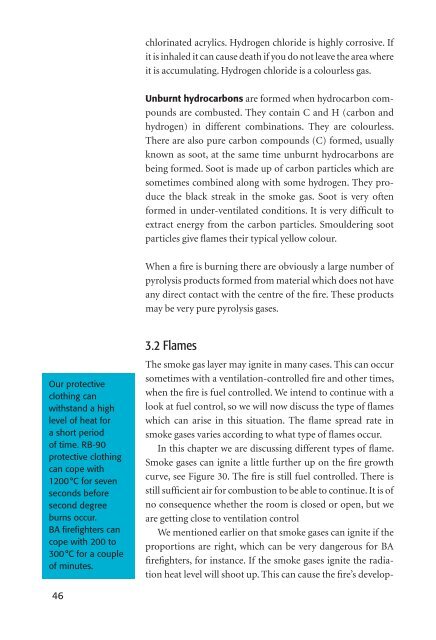You also want an ePaper? Increase the reach of your titles
YUMPU automatically turns print PDFs into web optimized ePapers that Google loves.
Our protective<br />
clothing can<br />
withstand a high<br />
level of heat for<br />
a short period<br />
of time. RB-90<br />
protective clothing<br />
can cope with<br />
1200 °C for seven<br />
seconds before<br />
second degree<br />
burns occur.<br />
BA fi refi ghters can<br />
cope with 200 to<br />
300 °C for a couple<br />
of minutes.<br />
46<br />
chlorinated acrylics. Hydrogen chloride is highly corrosive. If<br />
it is inhaled it can cause death if you do not leave the area where<br />
it is accumulating. Hydrogen chloride is a colourless gas.<br />
Unburnt hydrocarbons are formed when hydrocarbon compounds<br />
are combusted. They contain C and H (carbon and<br />
hydrogen) in different combinations. They are colourless.<br />
There are also pure carbon compounds (C) formed, usually<br />
known as soot, at the same time unburnt hydrocarbons are<br />
being formed. Soot is made up of carbon particles which are<br />
sometimes combined along with some hydrogen. They produce<br />
the black streak in the smoke gas. Soot is very often<br />
formed in under-ventilated conditions. It is very diffi cult to<br />
extract energy from the carbon particles. Smouldering soot<br />
particles give fl ames their typical yellow colour.<br />
When a fi re is burning there are obviously a large number of<br />
pyrolysis products formed from material which does not have<br />
any direct contact with the centre of the fi re. These products<br />
may be very pure pyrolysis gases.<br />
3.2 Flames<br />
The smoke gas layer may ignite in many cases. This can occur<br />
sometimes with a ventilation-controlled fi re and other times,<br />
when the fi re is fuel controlled. We intend to continue with a<br />
look at fuel control, so we will now discuss the type of fl ames<br />
which can arise in this situation. The fl ame spread rate in<br />
smoke gases varies according to what type of fl ames occur.<br />
In this chapter we are discussing different types of fl ame.<br />
Smoke gases can ignite a little further up on the fi re growth<br />
curve, see Figure 30. The fi re is still fuel controlled. There is<br />
still suffi cient air for combustion to be able to continue. It is of<br />
no consequence whether the room is closed or open, but we<br />
are getting close to ventilation control<br />
We mentioned earlier on that smoke gases can ignite if the<br />
proportions are right, which can be very dangerous for BA<br />
fi refi ghters, for instance. If the smoke gases ignite the radiation<br />
heat level will shoot up. This can cause the fi re’s develop-

















